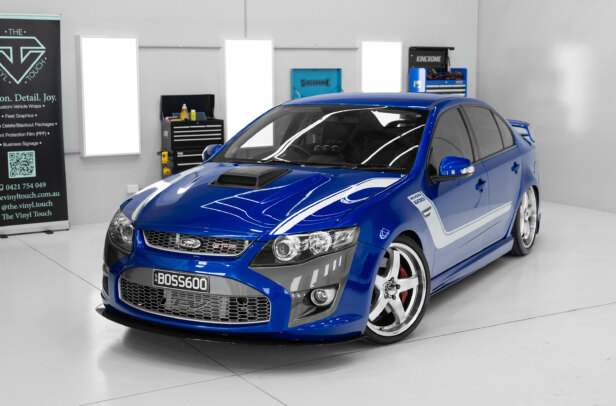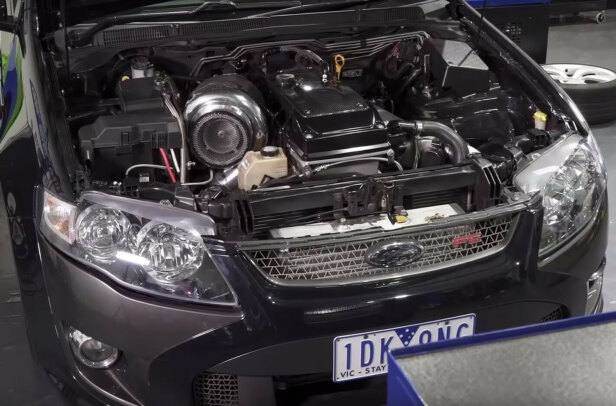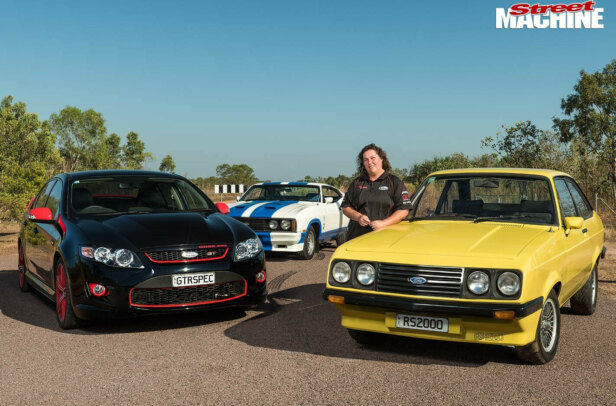As we pulled up for the tolls on the M5 out of Sydney, the bloke in the booth asked: “Is that Gary Myers in the car with you?” With the chat that followed, I was glad it wasn’t rush hour.
First published in the June 2006 issue of Street Machine

“Out in the country I’m nobody but whenever I come to the city I get that — I can be filling up with fuel and get asked for autographs,” Gary says as we drive on.
In the world we’re heading towards, Gary is a nobody. The drifters have heard of him, they respect his cars and the burnouts, but as the man freely admits, he’s got little experience on circuits and has never tried drifting.
Come to think of it, why is Street Machine at a drift practice day? Because a small group of engineers from FPV and Prodrive have built a drift car. Sadly not based on a V8, but we like the turbo six in the F6 Typhoon. Or Type Hoon, as it’s known around the office.

FPV’s PR man, Andrew Maclean, is the driving force behind the DRIF6 project. According to him, it’s become normal for FPV and Prodrive to build a car for the annual Family Open Day at the Campbellfield, Vic, HQ to highlight what the engineers are capable of.
“But it’s usually just dress-up; after it’s been shown, the bits are thrown away. That seemed wasteful to me — I wanted to make something that would last, that we could actually use,” he says.
With the F6 being rear-wheel drive and turboed, and the drift scene being about the fastest growing form of motorsport in Oz, it didn’t take long for the two to come together in his mind.




However, don’t go thinking Ford just jumped in with a bucket-load of cash and spare parts; FPV isn’t Ford and despite the cool looks, the car was a budget-build and a devoted spare-time project for Maclean and a couple of engineers. The car was donated — but not from the factory production line. It’s a former test-mule used for extreme temperature work out in the desert. It had also performed a crash test, collecting a ’roo that smashed in a good bit of the front passenger side. The engine was rough too, having racked up huge distances at high temps. A lower mileage donk was found and the body sorted. Working with begged and borrowed parts from sponsors and suppliers, the car was bolted together running about double the normal 8psi boost, and wearing a rollcage and stripped interior.
All good, but little testing has gone under its wheels. Hence the late phone call to invite us out to see it at Oran Park, where it joined some of Australia’s more established drift cars for a slide.


Despite being a drift novice, Gary’s obviously got lots of experience with high-power blown engines and breaking the rear tyres loose, so we thought it’d be a good idea to let him make the comparison.
Watching the DRIF6 on track, it’s immediately clear that it’s too softly sprung; where the other cars stay quite flat as they break traction and slide, the FPV car bounces and wallows. That’s probably because the car was developed not to drift — as you’d expect of a performance road car. It doesn’t want to hang the tail too aggressively and trying to provoke it makes it react. It needs more set-up work to make it happier with the tail hanging way out.

But the moment Gary steps into the car, it’s clear that the engine’s got what it takes. Even if a neat reverse-park into the gravel — narrowly avoiding the tyre wall — suggests the burnout maestro wasn’t able to walk drift’s fine line at his very first go.
“My engine is more instant,” he says, referring to his burnout car. “It gives more driver control — it wheelspins immediately. The power in this isn’t there straight away but when it does come on, it’s smooth and there’s plenty. But it’s nothing like my old thing!

“I could only drift in one direction — I don’t know if that’s from the burnouts or just how I feel with the car — but it’s definitely something I could get used to. It’d be great to set my burnout car up to drift and then step from that to this and see how they went back-to-back.
“I wasn’t really watching what the tacho was reading. It feels like you have to stay up it to keep the boost right on but if you run into the rev-limiter it drops too low.
“It’d be an awesome driver, though, as it is. Just to have one of these every day would be a lot of fun.”

So is DRIF6 doomed to be just another show car, albeit one that could actually race if there was the will to do it? Hopefully not — while the official word is that it’s not about to go racing, the build team is keen to get this thing out there on the drift scene. That’d really be one in the eye of the ricer brigade. Especially with a well-practised Gary Myers at the wheel.
BUILT TO DRIFT
Taking the basic F6 Typhoon, FPV ditched most of the interior and added a pair of MOMO race buckets, a sprinkling of Autron and VDO gauges including monster tacho, and a rollcage. The battery has been relegated to the back seat area as a K&N filter sucks air where the volts live in the road car.

That filter is part of the intake upgrade which sees air forced into a ram airbox through a hole where you’d expect to find the driver-side fog light. While the turbo is the same Garrett GT 35/40 unit as the stock F6 Typhoon, it’s boosting twice as hard at 16psi, and a larger-than-stock intercooler helps keep temperatures down. Replacing the usual individual inlet runners is a custom plenum manifold, while a three-inch straight-through exhaust system spits burnt gases at the kerb through a side pipe.
Dealing with the improved grunt is an upgraded Tremec T56 six-speed ’box which spins twin AP Racing clutch plates and a locked rear diff — vital for drifting.


Brakes are based on the optional Brembo kit for the F6, with additional braided hoses, brake proportioning valve and WRC-style handbrake.
Finishing off the sharp looks is a one-off bonnet made by Prodrive fabricator Eric Crene (who also made the manifold) with gills inspired by his drift-mad son.


DRIF6
| Body: | F6 Typhoon, four-door sedan |
| Engine: | Turbo-charged, intercooled 4.0-litre DOHC in-line six |
| Turbo: | Garrett GT 35/40, 16psi |
| Intercooler: | Front-mounted 600x300x75mm |
| Induction: | Hand-made twin-plenum manifold with custom three-inch turbo and intercooler pipes, ram-air intake into K&N pod filter |
| Engine Management: | Customised calibration |
| Exhaust: | Stainless three-inch straight-through with side outlet |
| Clutch: | AP Racing twin-plate |
| Differential: | Locked, 3.73:1 final drive |
| Brakes: | Cross-drilled, pillar-ventilated 355x32mm with Brembo six-piston monoblock calipers (f), 330x28mm rotors with Brembo monoblock four-piston calipers (r). HIS braided hoses, pull-operated hydraulic handbrake with Tilton proportioning valve |
| Seats: | MOMO |
| Steering wheel: | MOMO |
| Harnesses: | MOMO four-point, race |
| Gauges: | VDO monster tacho, Autron tyre pressure monitoring system |
| Wheels: | Dark Argent 19×8 five-spoke alloys |
| Tyres: | Dunlop SP Sport Maxx, 245/35 ZR19 |
| Power: | 380kW |
| Torque: | 700Nm |



Comments